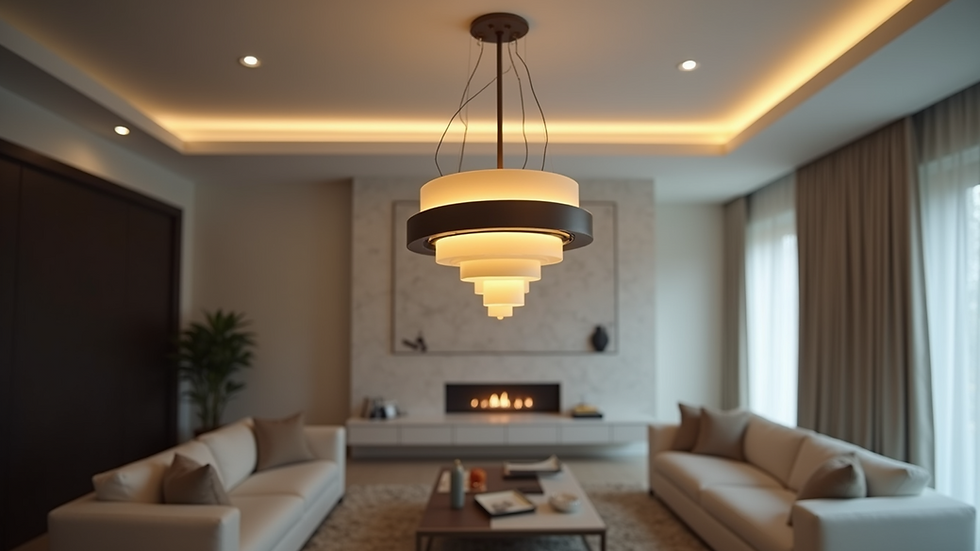How to Tailor Lighting to Match Any Space
- scotttrelfa
- Jul 14
- 4 min read
Lighting can play a pivotal role in the overall ambiance of a space. Whether you're updating your home decor or designing a new office, understanding how to tailor lighting to suit your needs can transform any environment. From creating a cozy living room atmosphere to enhancing productivity in workspaces, lighting sets the mood. Let's explore how to effectively tailor lighting to match any space.
Understanding Tailored Lighting
Tailored lighting refers to the precise selection of lighting features that complement the specific needs and aesthetics of a space. Each area serves different functions and, as such, requires distinct lighting solutions. For example, a dining room may benefit from softer, warmer tones to encourage relaxation and conversation, while a home office may require brighter, cooler lighting to enhance focus and productivity.
Research shows that proper lighting can improve mood and productivity; in fact, a well-lit workspace can increase employee performance by up to 20%. Understanding the different types of lighting and their effects allows you to tailor your approach effectively.
Types of Lighting to Consider
When designing your tailored lighting solution, it's essential to understand the three main types of lighting: ambient, task, and accent. Each type has its purpose and can be used in conjunction to achieve the perfect ambiance.
Ambient Lighting
Ambient lighting is the primary source of illumination in a space. It provides the overall light needed for visibility and sets the stage for the atmosphere. Natural light from windows, overhead fixtures, and wall-mounted lights all contribute to ambient lighting.
Recommended Approach:
Use dimmable LED fixtures or strategically placed lamps to allow for flexibility in changing the mood of the room. For instance, the use of pendant lights or chandeliers can create an inviting atmosphere in a dining area.

Task Lighting
Task lighting focuses on specific areas where activities like reading, cooking, or working occur. This type of lighting is essential for improving visibility and reducing eye strain.
Recommended Approach:
Install under-cabinet lighting in the kitchen to illuminate countertops or desk lamps in a home office for concentrated clarity. Adjustable fixtures can provide more versatility, allowing you to direct light to where it is needed most.

Accent Lighting
Accent lighting adds drama and a visual appeal to a space. It highlights particular features like artwork, architecture, or decor elements, creating focal points.
Recommended Approach:
Use wall sconces or spotlights to draw attention to artwork or decorative pieces. This not only enhances the aesthetic charm but also adds depth to the visual experience of the room.
Incorporating Custom Lighting Solutions
Integrating different sources of light can maximize the utility and beauty of your space. When working on tailored lighting designs, consider investing in custom lighting solutions. These solutions allow you to select specific fixtures and designs that suit your style while meeting your functional needs.
Custom lighting solutions can range from simple adjustments to comprehensive lighting plans tailored to your needs. For instance, a modern pendant light might look stunning over a rustic dining table, blending styles effectively while providing appropriate lighting.
Choosing the Right Bulb
The type of light bulb you choose can significantly affect how your space feels. There are primarily three categories of light bulbs: incandescent, fluorescent, and LED.
Incandescent: These traditional bulbs emit a warm light that closely resembles natural sunlight but are less energy-efficient.
Fluorescent: While energy-efficient, these bulbs can produce a harsh glare that may not be ideal for all spaces.
LED: The most popular option today, LED bulbs offer versatility, energy efficiency, and a range of color temperatures.
Recommended Approach:
For softer, more inviting lighting, opt for warm white LED bulbs in living spaces and cooler tones in workspaces.

Practical Tips for Tailoring Lighting
Here are some actionable recommendations for tailoring lighting to match your space:
Evaluate Your Space: Take time to assess each area and determine how you want the lighting to function. Consider factors such as the size of the room, furniture layout, and existing light sources.
Layer Your Lighting: Use a combination of ambient, task, and accent lighting to create a well-rounded lighting scheme. This layering approach allows for versatility and can set the mood for various activities.
Use Dimmers: Installing dimmer switches provides adjustable brightness and gives you control over the ambiance. This feature is essential for spaces that serve multiple purposes, such as a living room that functions as both a lounge and a workspace.
Color Matters: The color temperature is measured in Kelvins (K). Warmer colors (below 3000K) are ideal for relaxation areas, while cooler colors (above 4000K) foster productivity and concentration.
Consider Natural Light: Make the most of what nature provides by using window treatments that allow natural light in while offering privacy as needed. Mirrors can also be used strategically to reflect light and enhance the space.
By following these tips, you will ensure that your tailored lighting complements the overall design and functionality of the space.
Final Thoughts on Tailored Lighting
Tailoring lighting to suit any space is not merely about illumination; it's about creating an environment that reflects your style and meets your needs. With a shifted perspective on lighting and a strategic approach, you can enhance the aesthetics and functionality of any area in your home or office.
Remember that investing time in understanding the different types of lighting and how they can be combined will significantly aid in achieving the desired effect for your spaces. From creating cozy corners in your home to optimizing workflows in the office, the right lighting solution can make all the difference.








Comments